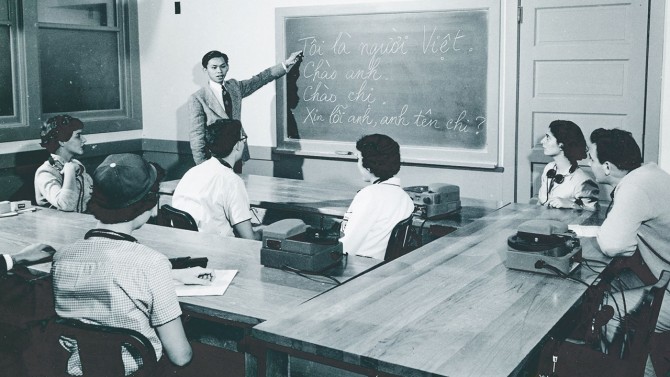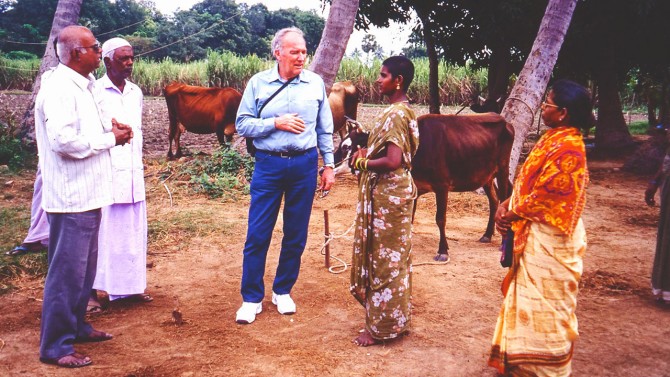
A visit to a pilgrimage site in Nepal during study abroad in 2009-10.
New book chronicles Cornell’s international impact
By Corey Ryan Earle
If you think traveling to Ithaca is difficult today, imagine sailing across the ocean 150 years ago, your belongings packed into a steamer trunk, anxiously anticipating enrolling at a new university in a country that you’ve never visited before.
When Cornell opened its doors in 1868, students and faculty had already begun to travel from overseas. Since then, the university has been leading teaching, research and outreach efforts that span countries and continents, and its community is as global as it has ever been.
Now, for the first time, the breadth and depth of this international footprint has been chronicled in a book: “Beyond Borders: Exploring the History of Cornell’s Global Dimensions,” published in association with Cornell University Press and with support from Cornell Academics & Professors Emeriti.
The project was the vision of Royal Colle, Ph.D. ’67, professor emeritus of communication, who began collecting stories about Cornell’s international involvement two decades ago.
Colle’s academic career involved research and extension around the world, partnering with agencies like the Ford Foundation, World Bank, and World Health Organization.
Recognizing that much of Cornell’s international work had not been documented in previous books about the university, Colle recruited a team of editors to help bring the project to fruition: Heike Michelsen, former director of programming at the Mario Einaudi Center for International Studies; Elaine Deutsch Engst, M.A. ’72, university archivist emerita and former director of the Division of Rare and Manuscript Collections; and myself.
After nearly three years of production, the book comprises 58 chapters about aspects of Cornell’s global dimensions.
Its 54 authors include many faculty and staff who played direct roles in those endeavors.
The editorial team sought stories representing a wide range of disciplines, regions and cultures, while also documenting the history of institutional programs and services like Education Abroad, the Holland International Living Center and Cornell in Rome, to name a few.
While comprehensiveness is impossible with a book of this nature, even the most knowledgeable Cornellian will learn something new in each chapter. To whet your appetite, here are just a few anecdotes:
- From 1924-31, Cornell collaborated with China’s University of Nanking (now Nanjing) in what has been called the “first notable example of international technical cooperation in agriculture,” resulting in the development of better varieties of wheat, barley, rice and other crops.
- Geology professor Charles Hartt recruited so many Brazilian students in the 1870s that they formed the university’s first international student group, Club Brasileiro, which also published a Portuguese newsletter.
- Generations of students have had life-changing opportunities through the long-running course, International Agriculture in Developing Nations (established in 1968), and its trips around the world.
- Cornell was a pioneer in language instruction, creating a Division of Modern Languages in the 1940s and helping popularize a teaching method that focused on conversation taught by linguists and native speakers, with reading and writing considered secondary.
- By 2021, more than 65,000 farms in Bangladesh were growing Bt brinjal, a bioengineered pest-resistant eggplant developed and commercialized thanks to a Cornell-led consortium.
- Home economics pioneer Flora Rose led an extensive field survey focused on nutrition in Belgian children after World War I, paving the way for future research and extension efforts in international nutrition.
- As an undergraduate, Hu Shih 1914 (namesake of a new residence hall), organized a group of Chinese students to donate Chinese-language books to the library, strengthening its world-class Asia collections.
- In the first year of the university’s formal study abroad program (1985-86), 259 students did so for at least a semester, nearly tripling the 88 of the previous year.
- In 1933, Cornell became the first U.S. college or university to dedicate a staff member to working with international students, then numbering about 175. That staffer’s father, John Mott 1888, remains the only Cornellian to win the Nobel Peace Prize.
“Beyond Borders” is available in paperback, hardcover and e-book form. It can be purchased from the publisher and at online retailers such as Amazon, or can be ordered through your local bookstore. Several of its editors will attend the annual Reunion Book Signing at the Cornell Store.
Read the full story on the Cornellians website.
Corey Ryan Earle ’07 is a contributing editor at Cornellians and a staff member in Alumni Affairs and Development.
Media Contact
Get Cornell news delivered right to your inbox.
Subscribe


